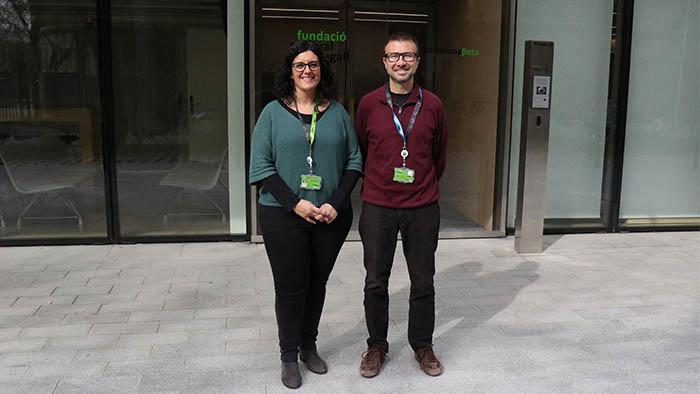25 Mayo | 2020
La contaminación del aire provoca daños en zonas cerebrales vinculadas al Alzheimer

Dra. Marta Crous-Bou y Dr. José Luis Molinuevo, autores principales del estudio
Investigadores del Barcelonaβeta Brain Research Center (BBRC), centro de la Fundación Pasqual Maragall, en colaboración con ISGlobal, ambos centros impulsados por la Fundación ”la Caixa”, han detectado que las personas más expuestas a dióxido de nitrógeno (NO2) y partículas en suspensión del aire de menos de 10 µm de diámetro (PM10), presentan una mayor atrofia cerebral y un menor grosor cortical en áreas específicas del cerebro que se ven afectadas en la enfermedad de Alzheimer. El estudio ha sido publicado recientemente en la revista Environment International.
“Los resultados de nuestra investigación van en línea con los estudios científicos recientes que demuestran que la contaminación del aire tiene un impacto nocivo en el cerebro y está relacionada con la incidencia de demencias”, destaca la Dra. Marta Crous-Bou, primera autora del estudio y colaboradora científica del BBRC. En este caso, tal y como explica, “nuestro estudio aporta por primera vez evidencia sobre el impacto negativo que la polución del aire puede tener en zonas del cerebro estrechamente vinculadas a la enfermedad de Alzheimer en personas de mediana edad sin problemas cognitivos”.
El estudio ha sido liderado por el grupo de Investigación Clínica, Biomarcadores y Factores de Riesgo, dirigido por el Dr. José Luis Molinuevo en el BBRC, y ha contado con el impulso de la Fundación ”la Caixa”, y la colaboración del Instituto de Salud Global de Barcelona (ISGlobal), el CIBER de Fragilidad y Envejecimiento Saludable (CIBERFES), el CIBER de Epidemiología y Salud Pública (CIBERESP) y el CIBER de Bioingeniería, Biomateriales y Nanomedicina (CIBER-BBN).
Estudio realizado en Barcelona
La recogida de datos para la investigación se llevó a cabo entre el 2013 y el 2014 sobre 958 participantes cognitivamente sanos del Estudio Alfa del BBRC, residentes durante al menos tres años en el mismo domicilio en la ciudad de Barcelona.
Para calcular el nivel de exposición de los participantes a los gases y partículas contaminantes, el equipo de investigadores de ISGlobal, dirigido por Mark J. Nieuwenhuijsen, utilizó los datos recogidos en Barcelona en el marco del proyecto europeo ESCAPE, durante tres estaciones diferentes del año, y los cruzó con las direcciones de los participantes. El periodo de recogida de datos no es determinante en este estudio, ya que la distribución espacial de la contaminación del aire en Barcelona ha sido bastante consistente durante los últimos 20 años.
Paralelamente, gracias a las extensas pruebas que se hicieron un subgrupo de participantes del Estudio Alfa en la resonancia magnética, los investigadores del BBRC analizaron las áreas cerebrales que más se ven afectadas en la enfermedad de Alzheimer y las compararon con la exposición a la contaminación ambiental. Es en este punto donde detectaron que los barceloneses más expuestos a la polución del aire presentaban un grosor cortical inferior y una mayor atrofia cerebral respecto a los participantes menos expuestos.
Por el contrario, los investigadores observaron que los participantes más expuestos a zonas verdes tenían un mayor grosor en el córtex de determinadas áreas cerebrales. Por lo tanto, estas personas presentaban una mayor resiliencia a la enfermedad de Alzheimer que los participantes más expuestos a los contaminantes NO2 i PM10, que provienen principalmente de la combustión de carburantes de los vehículos y de las plantas industriales. En este caso, los investigadores apuntan que no se trata de un beneficio directo de los espacios verdes, sino que más bien de una menor exposición a la polución.
Además de medir el impacto de la contaminación del aire y de las zonas verdes en la estructura cerebral, los investigadores también analizaron el impacto de estos dos factores y del ruido en el rendimiento cognitivo, pero no encontraron resultados significativos.
Próximos pasos
Los investigadores del BBRC ya han presentado en la Alzheimer’s Association International Conference los resultados de nuevos análisis hechos en la estructura cerebral global de los participantes que demuestran que hay alteraciones en la substancia blanca y gris de las personas más expuestas a los contaminantes. Por este motivo, el Dr. José Luis Molinuevo, Director del Programa de Prevención del Alzheimer del BBRC y coautor del estudio, asegura que “la contaminación es un factor de riesgo más del Alzheimer, ya que su exposición sostenida en el tiempo puede hacer el cerebro más vulnerable facilitando el desarrollo del deterioro cognitivo asociado a la enfermedad”.
En este sentido, el Dr. Mark Nieuwenhuijsen, responsable de la Iniciativa de Planificación Urbana, Medio Ambiente y Salud de ISGlobal, asegura que “no podemos seguir manteniendo por más tiempo este modelo de ciudad donde predomina el vehículo contaminante. Es necesario incrementar el transporte público y activo, apostar por las energías renovables, por la electrificación del transporte motorizado y de los sistemas de calefacción y reducir las emisiones del puerto y de la industria”.











